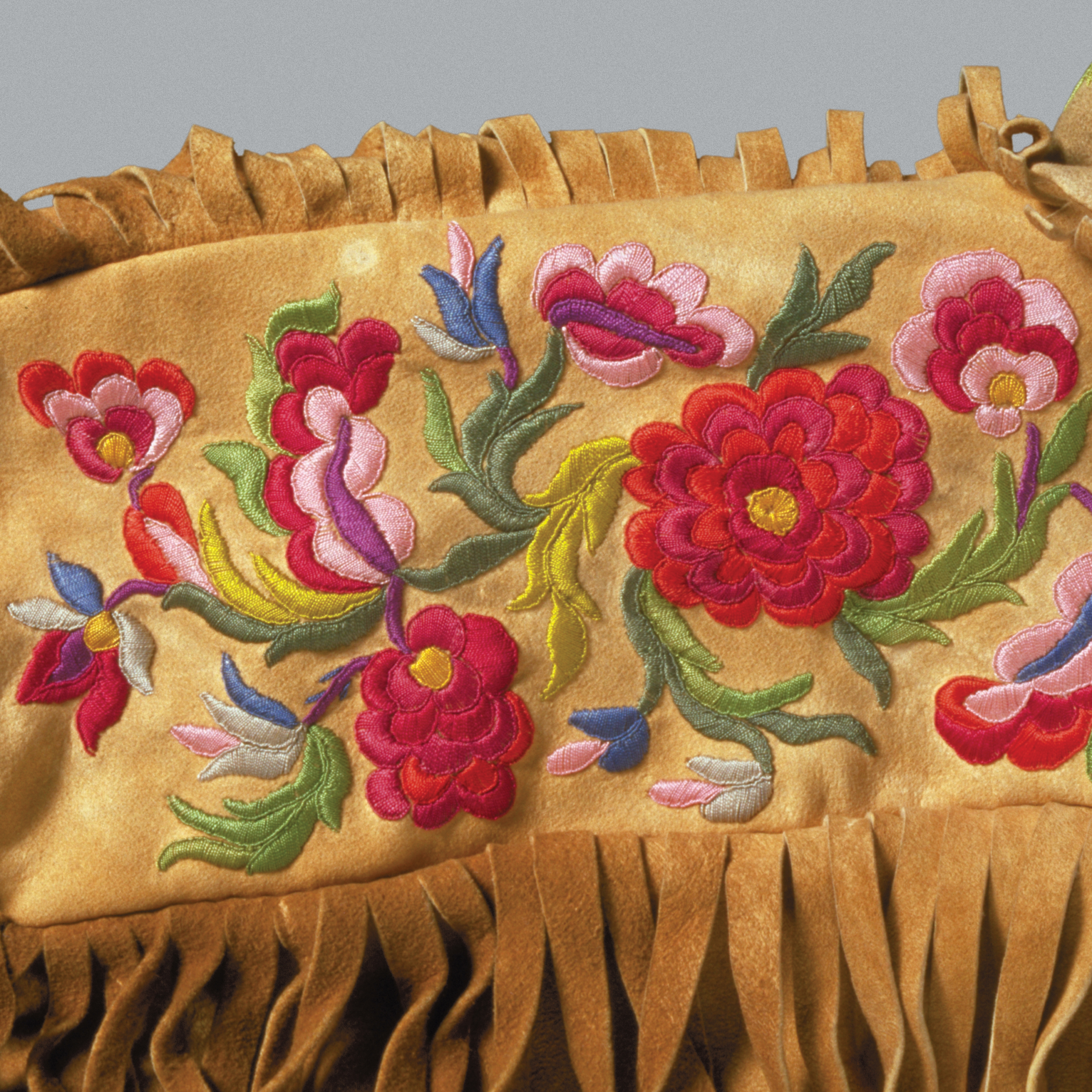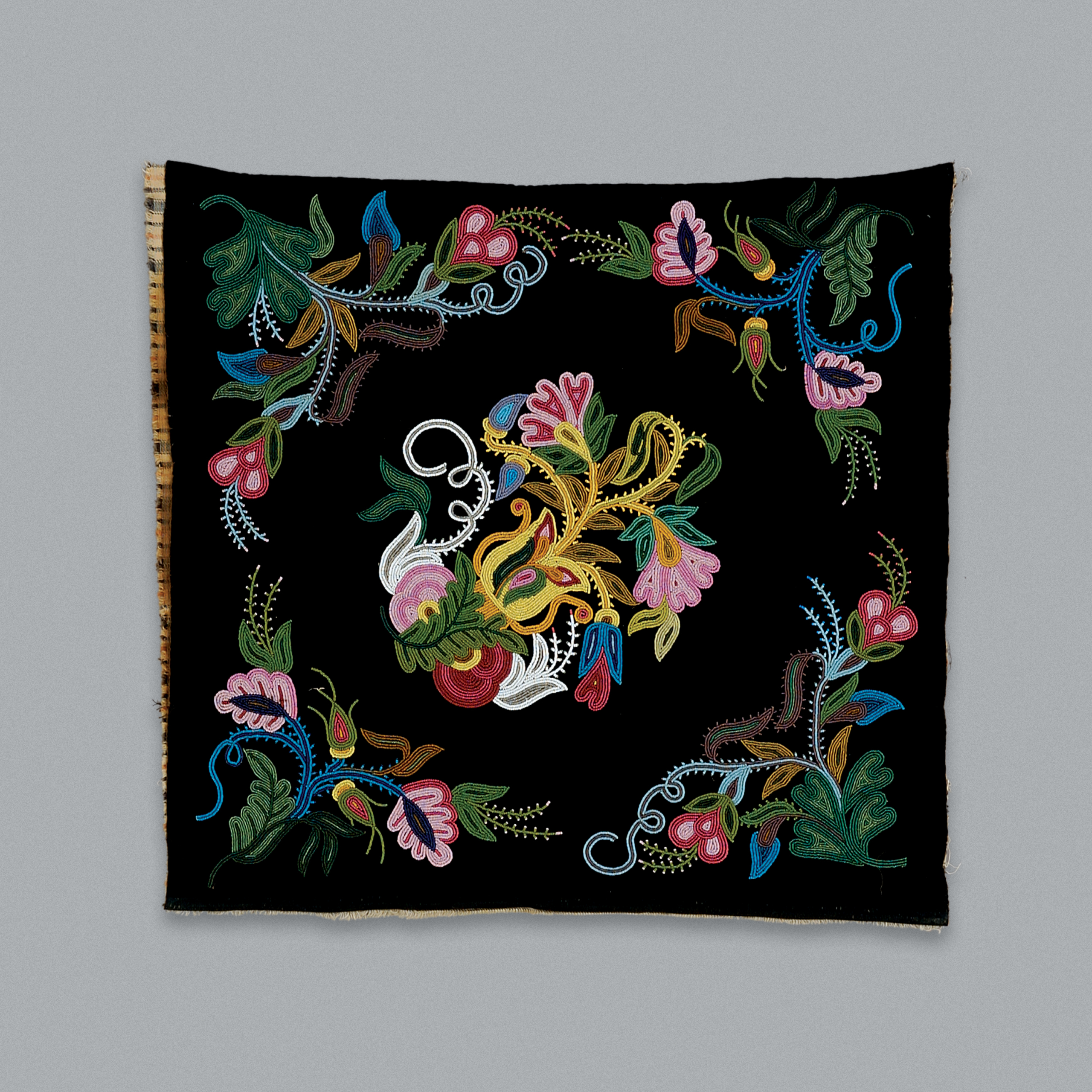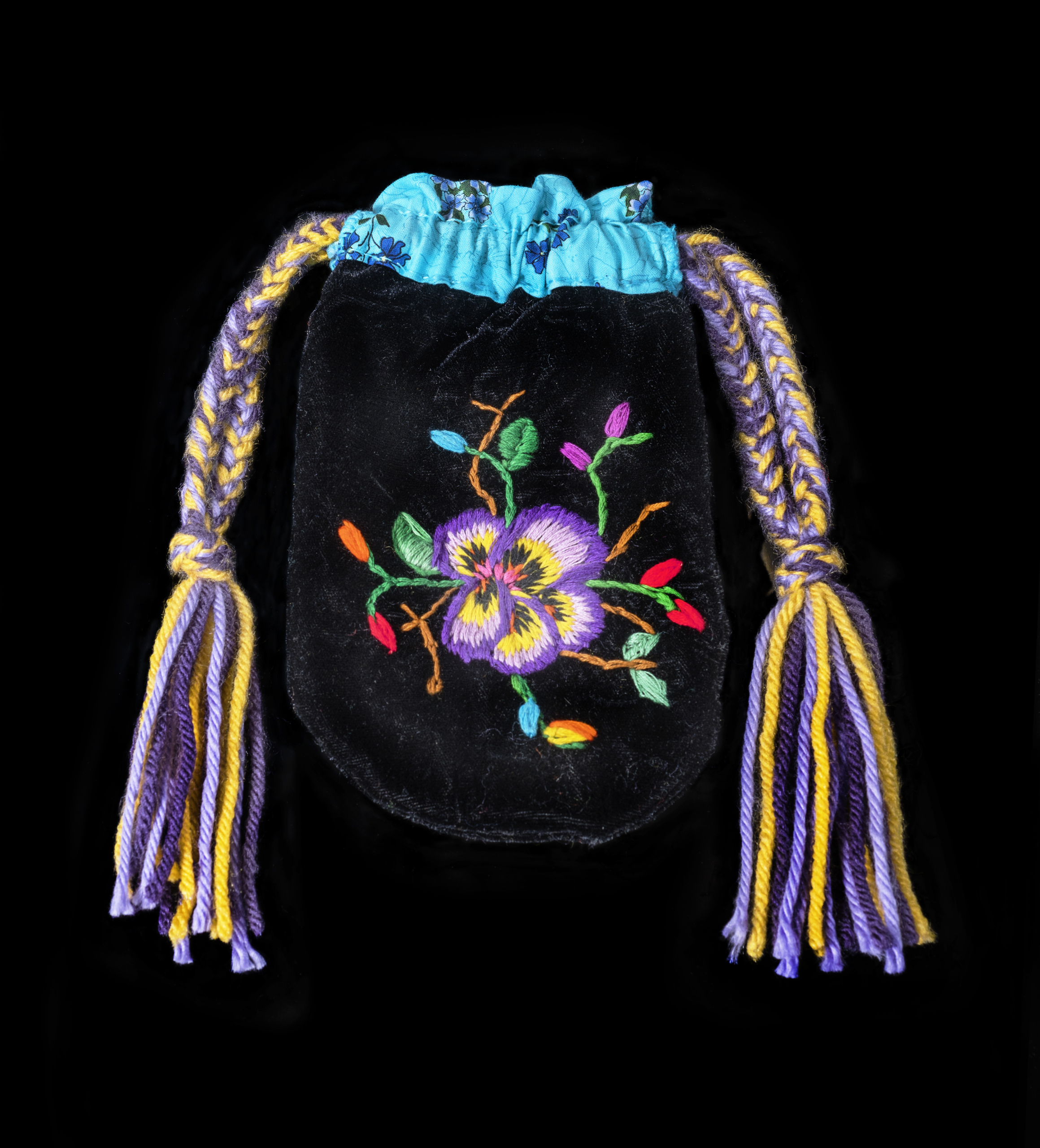Métis Floral Design
Artifact
Image
Video
Audio
 Activities
Activities
LOOK
Look at the photos of the different types of Métis floral designs in the media carousel above. What are similarities between them? What are some differences?
LOOK
Watch the interview with Karen Anderson. She shares why beading and embroidery are important to her. What are her main points?
Details
 Materials
Materials - Deer hide
- Animal sinew
- Cotton thread
- Metal
Historical Context
Choose one of the three levels below to match your needs.
- Here are examples of Métis floral designs using embroidery thread and glass beads.
- Developing a distinctive style of needlework, quillwork and beadwork, women blended the artistic practices of their Indigenous and non-indigenous kin to create bright and elaborate designs. These beadwork and embroidery designs are often floral.
- Like many artistic practices, beadwork and embroidery are often taught in person, by way of oral or hands-on transmission.
Scroll through the media carousel above to see an example of Métis beading from the Museum’s collection, a picture of the beadwork sample included in the History Box, and an interview with Karen Andersen, the artist.
Here are examples of Métis floral designs using embroidery thread and glass beads. Together, these designs represent over 200 years of Métis artistic practice and influence across what is currently known as Canada.
Métis women played a critical role in the birth and growth of this new People and Nation. Developing a distinctive style of needlework, quillwork and beadwork, they blended the artistic practices of their other Indigenous and non-indigenous kin to create bright and elaborate designs. These beadwork and embroidery designs are often floral.
Like many artistic practices, beadwork and embroidery are often taught in person, by way of oral or hands-on transmission. For many, the stories and knowledge shared while creating is just as important as the techniques being exchanged.
These examples of Métis floral designs involve the use of embroidery thread and glass beads. Together, these designs represent more than 200 years of Métis artistic practice and influence across what is currently known as Canada.
Métis women played a critical role in the birth and growth of the Métis Nation and people. Developing a distinctive style of needlework, quillwork and beadwork, they blended the artistic practices of their other Indigenous and non-indigenous kin to create the bright and elaborate designs that adorned much of their clothing and other accessories. These beadwork and embroidery designs are often floral, with patterns of curving stems, delicate leaves, berries, flower buds and flowers.
Made with great care, Métis beadwork and embroidery are often placed on highly visible areas where there is little wear, such as the backs of mittens, hats, moccasin vamps, and the back yokes of jackets. Colour and designs are often associated with specific families.
As with many artistic practices, beadwork and embroidery are often passed down through the generations, either orally or through hands-on instruction. For many, the stories and knowledge shared during the creative process are just as important as the techniques being exchanged.
Having learned from their grandmothers, mothers, and aunts, Métis women continue this artistic tradition today.
- Here are examples of Métis floral designs using embroidery thread and glass beads.
- Developing a distinctive style of needlework, quillwork and beadwork, women blended the artistic practices of their Indigenous and non-indigenous kin to create bright and elaborate designs. These beadwork and embroidery designs are often floral.
- Like many artistic practices, beadwork and embroidery are often taught in person, by way of oral or hands-on transmission.
Scroll through the media carousel above to see an example of Métis beading from the Museum’s collection, a picture of the beadwork sample included in the History Box, and an interview with Karen Andersen, the artist.
Here are examples of Métis floral designs using embroidery thread and glass beads. Together, these designs represent over 200 years of Métis artistic practice and influence across what is currently known as Canada.
Métis women played a critical role in the birth and growth of this new People and Nation. Developing a distinctive style of needlework, quillwork and beadwork, they blended the artistic practices of their other Indigenous and non-indigenous kin to create bright and elaborate designs. These beadwork and embroidery designs are often floral.
Like many artistic practices, beadwork and embroidery are often taught in person, by way of oral or hands-on transmission. For many, the stories and knowledge shared while creating is just as important as the techniques being exchanged.
These examples of Métis floral designs involve the use of embroidery thread and glass beads. Together, these designs represent more than 200 years of Métis artistic practice and influence across what is currently known as Canada.
Métis women played a critical role in the birth and growth of the Métis Nation and people. Developing a distinctive style of needlework, quillwork and beadwork, they blended the artistic practices of their other Indigenous and non-indigenous kin to create the bright and elaborate designs that adorned much of their clothing and other accessories. These beadwork and embroidery designs are often floral, with patterns of curving stems, delicate leaves, berries, flower buds and flowers.
Made with great care, Métis beadwork and embroidery are often placed on highly visible areas where there is little wear, such as the backs of mittens, hats, moccasin vamps, and the back yokes of jackets. Colour and designs are often associated with specific families.
As with many artistic practices, beadwork and embroidery are often passed down through the generations, either orally or through hands-on instruction. For many, the stories and knowledge shared during the creative process are just as important as the techniques being exchanged.
Having learned from their grandmothers, mothers, and aunts, Métis women continue this artistic tradition today.
Summary
- Here are examples of Métis floral designs using embroidery thread and glass beads.
- Developing a distinctive style of needlework, quillwork and beadwork, women blended the artistic practices of their Indigenous and non-indigenous kin to create bright and elaborate designs. These beadwork and embroidery designs are often floral.
- Like many artistic practices, beadwork and embroidery are often taught in person, by way of oral or hands-on transmission.
Scroll through the media carousel above to see an example of Métis beading from the Museum’s collection, a picture of the beadwork sample included in the History Box, and an interview with Karen Andersen, the artist.
Essential
Here are examples of Métis floral designs using embroidery thread and glass beads. Together, these designs represent over 200 years of Métis artistic practice and influence across what is currently known as Canada.
Métis women played a critical role in the birth and growth of this new People and Nation. Developing a distinctive style of needlework, quillwork and beadwork, they blended the artistic practices of their other Indigenous and non-indigenous kin to create bright and elaborate designs. These beadwork and embroidery designs are often floral.
Like many artistic practices, beadwork and embroidery are often taught in person, by way of oral or hands-on transmission. For many, the stories and knowledge shared while creating is just as important as the techniques being exchanged.
In-Depth
These examples of Métis floral designs involve the use of embroidery thread and glass beads. Together, these designs represent more than 200 years of Métis artistic practice and influence across what is currently known as Canada.
Métis women played a critical role in the birth and growth of the Métis Nation and people. Developing a distinctive style of needlework, quillwork and beadwork, they blended the artistic practices of their other Indigenous and non-indigenous kin to create the bright and elaborate designs that adorned much of their clothing and other accessories. These beadwork and embroidery designs are often floral, with patterns of curving stems, delicate leaves, berries, flower buds and flowers.
Made with great care, Métis beadwork and embroidery are often placed on highly visible areas where there is little wear, such as the backs of mittens, hats, moccasin vamps, and the back yokes of jackets. Colour and designs are often associated with specific families.
As with many artistic practices, beadwork and embroidery are often passed down through the generations, either orally or through hands-on instruction. For many, the stories and knowledge shared during the creative process are just as important as the techniques being exchanged.
Having learned from their grandmothers, mothers, and aunts, Métis women continue this artistic tradition today.



